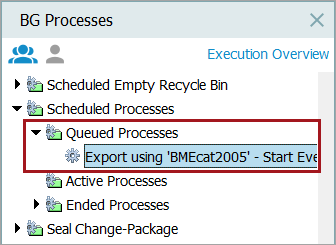For all BGP execution mechanisms, states are indicated by the folders below each node on the BG Processes tab. The status of a BGP is displayed on the Background Process tab.
Queued Processes State
The queued processes list includes processes which are in queue but have not yet been started. When the queued process is started it moves to the active process node.

Active Processes State
The active processes list includes processes which are currently being executed.
Active processes that have failed remain in the active process node but are highlighted with red colored text.
- For failed IIEP processes, refer to the Handling Failed IIEP Background Processes topic in the Data Exchange documentation.
- For failed OIEP processes, refer to the Handling Failed OIEP Background Processes topic in the Data Exchange documentation.
To abort an active BGP, select it, open the Maintain menu, and click Delete. The process is moved to the Ended Processes folder.

Completed with Errors Processes State
The completed with errors processes list includes processes that partially completed but also had errors. The minor errors are displayed with the details, but the events that can be processed will eventually complete.
Note: The 'Completed with Errors' option is only available for some processes including Asset importer process, Import Manager Pipeline, Match Code Processes, Smartsheet Import, and StateflowDeadline.

Ended Processes State
The ended processes list includes processes which have been completed without any errors, or in the case of Scheduled Processes, those that have been aborted.

Quarantined Status
For all BGP execution mechanisms, STEP prevents repeated restarts of background processes (BGPs) that were running on an application server / node that crashed. The quarantine fail-safe mechanism prevents continuous loops of server / node crashes caused by BGPs.
If a BGP seems to be a potential cause of an application server / node crash, STEP moves the background process into a 'failed' state and does not restart it automatically. Additionally, the BGP goes into a 'quarantined' status which requires user intervention.
Note: When the system administrator is shutting down an application server, it is important to do so with the proper tools, as simply killing the application server JVM for STEP or cutting power will be interpreted as a crash and may cause this mechanism to be triggered. Shutting down a STEP application server with the proper tools will not have this effect.
Analyze the reason for quarantine to determine the next action to take. Not all quarantined background processes cause a crash. In some cases, timing makes it difficult to automatically detect the reason.
Sometimes, an application server / node crash is not caused by the specific background process that was quarantined. If the issue can be found and fixed, the quarantined background process can be restarted from the workbench. Alternatively, if you determine that the quarantined background process should not be started again, it can be deleted.
Integration Endpoints
Integration endpoints will halt if any of their associated background processes are quarantined to avoid starting background processes which could cause the same problem repeatedly. The execution reports of both the integration endpoint and the background process will indicate the connection between the two processes. It is strongly recommended to first address any other quarantined background processes of the integration endpoint, then manually restart the integration endpoint in the workbench. Resuming an integration endpoint will not resume any associated quarantined background processes.
Important: It is vital to monitor integration endpoints so they can be restarted after such an incident. Sensors for integration endpoints are available for this purpose, defined in the Sensors for External Monitoring topic in the Administration Portal documentation.
Quarantined Status Values
The Quarantine Status property only displays if a background process is or has ever been quarantined. Otherwise, the property line does not show on the BGP tab. If a background process has been quarantined, one of the following values is displayed:
Quarantined - When the background process is currently in quarantine and in most cases, the background process is in a 'failed' state.

Restart acknowledged - A quarantined background process has restarted, but is not yet being executed, e.g., because it just happened or it is waiting on its execution queue. Typically, the process is in 'waiting' state.

Previously Quarantined - A background process that is no longer quarantined and can now be in any of the possible BGP states.
Searching for Quarantined BGPs
To find quarantined background processes:
-
On the Advanced Search tab, select the Background Process Search from the criterion dropdown.
-
In the Quarantined parameter, select Quarantined, Previously Quarantined, or Restart Acknowledged.
-
Click the Search button to view the results.